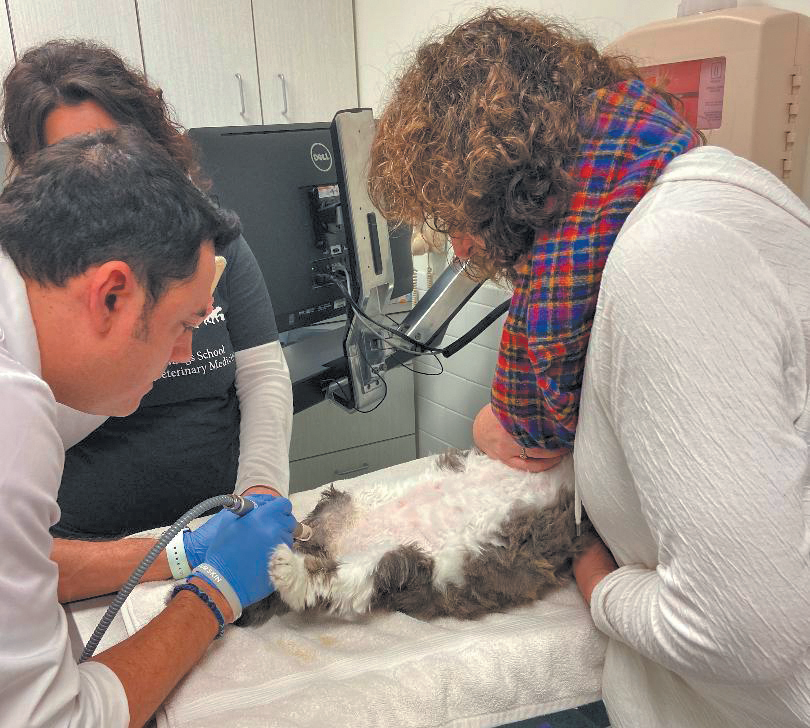The Cummings School at Tufts University has reportedly become the first veterinary facility in the U.S. to use a new treatment for speeding up wound healing in cats and other pets. Called cold plasma therapy, it appears to hasten the skin’s return to normal when it has been compromised by such things as cuts and abscesses. It also clears the crusting, scaling, inflammation, and eruptions that sometimes appear as the result of infections associated with allergies and other conditions.
Cold plasma therapy has already been used in veterinary medicine in Europe for a few years. Tufts veterinary dermatologist Ramn Almela, DVM, learned about it while practicing in Germany before coming to the U.S. and has now brought it to the Tufts Cummings School of Veterinary Medicine.
Dr. Almela’s first cold plasma patient stateside is a 16-year-old long-haired cat named Brandi. She had a raised spot on the inside of one of her back limbs that her owner, Sandi Gangi, first noticed a year ago. Even with antiseptic sprays prescribed by Brandi’s primary care veterinarian, the lesion would become red and inflamed and kept scabbing over because of a stubborn infection at the location, perhaps resulting from allergies. But within two treatments with cold plasma therapy administered by Dr. Almela, Ms. Gangi says, “I am finally starting to see a difference.”
What is cold plasma therapy?
People think of matter as solid, liquid, or gas, but there is a fourth state: plasma. Plasma is what lightning is made of. “It’s somewhere between a gas and a liquid,” Dr. Almela says.
In the case of cold plasma therapy, a gas, argon, is turned into plasma. Then, aimed at a wound with the use of a wand kept just off the body, the argon plasma is believed to regenerate healthy tissue via cell proliferation and angiogenesis — the creation of new blood vessels that nourish tissue.
At the same time that it promotes the growth of healthy cells, cold plasma therapy kills bacteria responsible for infections that can keep skin lesions from healing. Scientists and clinicians who are enthusiastic about the treatment believe it might even be an antidote to antibiotic resistance, which is the growing ability of harmful bacteria to resist antibiotics’ ability to kill them.
Research has suggested that the bacteria-killing ability of cold plasma therapy can help kill bacteria responsible for tooth decay, too. The plasma can easily coat crevices in the mouth that are difficult to reach with other dental decay-fighting mechanisms.

Scientific proof not yet nailed down
It must be noted that despite veterinarians’ clinical experience with cold plasma therapy and despite case studies reported in scientific journals, hard research on the procedure remains lacking in animals. In human medicine there are at least a few high-level studies comparing groups treated with cold plasma therapy to control groups. But there are no studies published in peer-reviewed publications that take, say, two groups of cats with similar skin wounds and compare their healing after giving one group standard treatment and the other, standard treatment plus cold plasma. In other words, the evidence in the veterinary field remains purely in the realm of anecdotal.
“A good analogy would be laser therapy,” Dr. Almela says. It is said to reduce the pain of such things as compromised joints, neurological problems, and fluid build-up that can reduce mobility, but there are no published studies of laser therapy in two groups of subjects proving that laser beams reduce pain more than standard pain treatments. Yet laser therapy is increasingly used in veterinary medicine, and veterinarians say they note a difference after laser applications.
“We need more hard evidence,” Dr. Almela says, “but the word of practicing clinicians is spreading.” Cold plasma therapy actually started with human medicine in Europe about 15 years ago.
Researchers are convinced enough of cold plasma therapy’s potential benefits that the Food and Drug Administration has recently approved its use in a clinical trial to see if it can eradicate remaining cancer cells after surgical removal of a malignant mass. The technology is expected to kill tumor cells by a mechanism similar to the way it kills harmful bacteria — by damaging malignant cells with the use of oxygen in the form of free radicals, which destroys diseased tissue.
Moving forward
No one is suggesting that cold plasma therapy should take the place of standard treatments for wound healing, including such tools as anti-inflammatory drugs, anti-inflammatory topical medicines, antibiotics, and flea treatments (even if the cat has not been shown definitively to be hosting fleas on its coat). In fact, part of Brandi’s healing no doubt comes from Dr. Almela’s use of all those medicinal tools.
But both Brandi’s owner, Ms. Gangi, as well as Dr. Almela, believe the cold plasma therapy is giving the beautiful cat’s wound healing a push. Better still, it’s completely safe — for the practitioner as well as the patient. “You don’t need special equipment — no gloves or glasses or ventilation,” notes Dr. Almela. At one of Brandi’s recent treatments, Ms. Gangi remained right in the room, even helping to hold her cat in place by putting her face right next to hers.
Moreover, the procedure is fast, about 30 seconds per square inch of affected skin, Dr. Almela says. And there is no need to sedate the animal because the treatment is painless. “The feeling is similar to a mild air flow,” he comments.
“We’re already starting to wean her off prednisone [an anti-inflammatory],” Ms. Gangi relates. “I understand that the gold-standard scientific proof is not in yet, but for me, the proof is visual; I can see it with my own eyes.”




